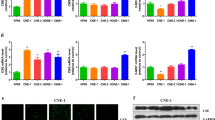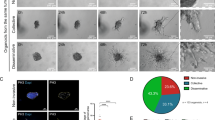Abstract
Kinase of embryonic stem cells (Kos1), a nonreceptor protein tyrosine kinase (NRPTK), was identified and cloned from differentiating murine embryonic stem cells. Kos1 is localized on mouse chromosome 11 that corresponds to human chromosome 17p13.1 and is homologous to Tnk1, Ack1 and Ack2, making it a new member of the Ack family of NRPTKs. Kos1 is a ubiquitously expressed 47-kDa protein with autotyrosine kinase activity that is developmentally regulated during embryogenesis. Kos1 is also upregulated following IL3 withdrawal from factor-dependent murine NSF/N1.H7 cells that undergo apoptosis, suggesting a role in growth inhibition. Stable overexpression of Kos1 inhibits growth of NIH 3T3 cells, while the kinase-dead Kos1(CN) promotes cell growth in both liquid culture and soft agar. In addition, forced expression of Kos1 inhibits Ras activity in an indirect mechanism that results in the downregulation of the Ras–Raf1–MAPK growth pathway. Furthermore, overexpression of Kos1 in NCI-H82 lung cancer cells that express oncogenic Ha-Ras(G12V) inhibits cell growth under reduced serum (0.5%) conditions in close association with the upregulation of the Ras inhibitor, Rap1A. Collectively, these data support a negative regulatory role for Kos1 in regulating the Ras–Raf1–MAPK growth pathway by a mechanism that requires its autotyrosine kinase activity.
This is a preview of subscription content, access via your institution
Access options
Subscribe to this journal
Receive 50 print issues and online access
$259.00 per year
only $5.18 per issue
Buy this article
- Purchase on SpringerLink
- Instant access to full article PDF
Prices may be subject to local taxes which are calculated during checkout












Similar content being viewed by others
References
Amrein KE, Flint NA, Panholzer B and Burn P . (1992). Proc. Natl. Acad. Sci. USA, 89, 3343–3346.
Aronheim A, Engelberg D, Li N, al-Alawi N, Schlessinger J and Karin M . (1994). Cell, 78, 949–961.
Avraham H, Avraham S and Taniguchi Y (2000). J. Hematotherapy Stem Cell Res., 9, 425–432.
Barradas M, Monjas A, Diaz-Meco T, Serrano, M. and Moscat J . (1999). EMBO J., 18, 6362–6369.
Bos JL . (1998). EMBO J., 17, 6776–6782.
Chomezynski P and Sacchi N . (1987). Anal. Biochem., 162, 156–159.
Cohen GB, Ren R and Baltimore D . (1995). Cell, 80, 237–248.
Copeland, N.G. and Jenkins, N.A (1991). Trends Genet., 7, 113–118.
Egan SE, Giddings BW, Brooks MW, Buday L, Sizeland AM and Weinberg RA . (1993) Nature, 363, 45–51.
Ernst M, Oates A and Dunn AR . (1996). J. Biol. Chem., 271, 30136–30143.
Erpel T and Courtneidge SA . (1995). Curr. Opin. Cell Biol., 7, 176–182.
Evans MJ and Kaufmann MH . (1981). Nature, 292, 154–196.
Fischer EH, Charbonneau H and Tonks NK . (1991). Science, 253, 401–406.
Frohman MA . (1993). Methods Enzymol., 218, 340–356.
Gibbs JB, Sigal IS, Poe M and Scolnick EM . (1984). Proc. Natl. Acad. Sci., USA, 81, 5704–5708.
Hanks SK and Hunter T . (1995). FASEB J., 9, 576–596.
Hanks SK, Quinn AM and Hunter T . (1988). Science, 241, 42–52.
Haucke V and De Camilli P . (1999). Science, 285, 1268–1271.
Higuchi R . (1989). PCR Technology: Principles and Applications for DNA Amplification. Henry A.E (ed). M. Stockton Press: New York, pp. 61–70.
Hoehn GT, Stokland T, Amin S, Ramirez M, Hawkins AL, Griffin CA, Small D and Civin CI . (1996). Oncogene, 12, 903–913.
Hole N, Graham GJ, Menzel U and Ansell JD . (1996). Blood, 88, 1266–1276.
Hopper NA, Lee L and Sternberg PW . (2000) Mol. Cell, 6, 65–75.
Isakov N, Wange RL, Burgess WH, Watts JD, Aebersold R and Samelson LE . (1995). J. Exp. Med., 181, 375–380.
Ito T, Deng X, Carr B and May SW . (1997). J. Biol. Chem., 272, 11671–11673.
Johnson LN, Noble MEM and Owen DJ . (1996). Cell, 85, 149–158.
Kavanaugh WM, Turck CW and Williams LT . (1995). Science, 268, 1177–1179.
Kavanaugh WM and Williams LT . (1994). Science, 266, 1862–1865.
Kinoshita T, Yokoto T, Arai K and Atsushi M . (1995). EMBO J., 14, 266–275.
Kitayama H, Sugimoto Y, Matsuzaki T, Ikawa Y and Noda M . (1989). Cell, 56, 77–88.
Laminet AA, Apell G, Conroy L and Kavanaugh WM . (1996). J. Biol. Chem., 271, 264–269.
Leevers SJ, Paterson HF and Marshall CJ . (1994). Nature, 369, 411–414.
Lin Q, Lo CG, Cerione RA and Yang W . (2002). J. Biol. Chem., 277, 10134–10138.
Lloyd AC, Paterson HF, Morris JD, Hall A and Marshall CJ . (1989). EMBO J., 8, 1099–1104.
Manne V, Bekesi E and Kung H-F . (1985). Proc. Natl. Acad. Sci. USA, 82, 376–380.
Manser E, Leung T, Salihuddin H, Tan L and Lim L . (1993). Nature, 363, 364–367.
Marte BM and Downward J . (1997). Trends Biochem. Sci., 22, 355–358.
Martin GR . (1981). Proc. Natl. Acad. Sci. USA, 78, 7634–7638.
Nakano T, Kodama H and Honjo T . (1996). Science, 272, 722–724.
Neet K and Hunter T . (1996). Genes Cells, 1, 147–169.
Neubauer H, Cumano A, Muller M, Wu H, Huffstadt U and Pfeffer K . (1998). Cell, 93, 397–409.
Nobes CD and Hall A . (1995). Cell, 81, 53–62.
Okada S, Matsuda M, Anafi M, Pawson T and Pessin JE . (1998). EMBO J., 17, 2554–2565.
Okuda K, Ernst TJ and Griffin JD . (1994). J. Biol. Chem., 269, 24602–24607.
Pandey A, Fernandez MM, Steen H, Blagoy B, Nielson MM, Roche S, Mann M and Lodish HF . (2000). J. Biol. Chem., 275, 38633–38639.
Parganas E, Wang D, Stravopodis D, Topham DJ, Marine JC, Teglund S, Vanin EF, Bodner S, Colamonici OR, van Deursen JM, Grosveld G and Ihle JN . (1998). Cell, 93, 385–395.
Reth M . (1989). Nature (London), 338, 383–384.
Sada K, Takano T, Yanagi S and Yamamura H . (2001). J. Biochem., 130, 177–186.
Sahai E and Marshall CJ . (2002). Nat. Rev. Cancer, 2, 133–142.
Sambrook J, Fritsch EF and Maniatis T . (1989). Molecular Cloning: A Laboratory Manual, 2nd Ed., Cold Spring Harbor Laboratory Press: Cold Spring Harbor, NY, pp. 1.53–1.73.
Satoh T and Kaziro Y . (1995). Methods Enzymol., 255, 149–155.
Schlessinger J . (2000). Cell, 103, 211–225.
Schmitt JM and Stork PJS . (2001). Mol. Cell. Biol. 21, 3671–3683.
Schmitt R, Bruyns E and Snodgrass R . (1991). Genes Dev., 5, 728–740.
Sem KP, Zahedi B, Tan I, Deak M, Lim L and Harden N . (2002) Mol. Cell. Biol., 22, 3685–3697.
Smith AG, Heath JK, Donaldson DD, Wong GG, Moreau J, Stahl M and Roger D . (1988). Nature, 336, 688–690.
Stahl N, Farrugella TJ, Boulton TG, Zhong Z, Darnell JE and Yancopoulos GD . (1995). Science, 267, 1701–1706.
Sun H, King AJ, Diaz B and Marshall MS . (2000). Curr. Biol., 10, 281–284.
Teo M, Tan L, Lim L and Manser E . (2001). J. Biol. Chem., 276, 18392–18398.
Wang HG, Rapp UR and Reed JC . (1996). Cell, 87, 629–638.
Weiss A . (1993). Cell, 73, 209–212.
Wiles M and Keller G . (1991). Development, 111, 259–267.
Wilks AK . (1989). Proc. Natl. Acad. Sci. USA, 86, 1603–1607.
William RL, Hilton DJ, Pease S, Wilson TA, Stewart CL, Gearing DP, Wagner EF, Metcalf D, Nicola NA and Gough NM . (1988). Nature, 336, 684–687.
Yamane T, Kunisada T, Yamazaki H, Era T, Nakano T and Hayashi S . (1997). Blood, 90, 3516–3523.
Yang JJ, Kang JS and Krauss RS . (1998). Mol. Cell. Biol., 17, 3850–3857.
Yang W and Cerione RA . (1997). J. Biol. Chem., 272, 24819–24824.
Yang W, Lin Q, Zhao J, Guan J and Cerione RA . (2001) J. Biol. Chem., 276, 43987–43993.
Yang W, Lo CG, Dispenza T and Cerione RA . (2001) J. Biol. Chem., 276, 17468–17473.
Acknowledgements
We are grateful to Drs NG Copeland and NA Jenkins for determining the chromosomal localization of Kos1. We thank Dr L Xiao for NCI-H82:Ras(G12V) cells. We thank Drs P Raychaudhuri, T Ito and R Miflin for their advice and fruitful discussions. This work is supported in part by the National Institute of Health Grants CA44649 and HL5408.
Accession number
GenBank database, Accession numbers for Kos1 sequences are AF307745 and AF307746.
Author information
Authors and Affiliations
Corresponding author
Rights and permissions
About this article
Cite this article
Hoare, K., Hoare, S., Smith, O. et al. Kos1, a nonreceptor tyrosine kinase that suppresses Ras signaling. Oncogene 22, 3562–3577 (2003). https://doi.org/10.1038/sj.onc.1206480
Received:
Revised:
Accepted:
Published:
Issue date:
DOI: https://doi.org/10.1038/sj.onc.1206480
Keywords
This article is cited by
-
miR-663b promotes colorectal cancer progression by activating Ras/Raf signaling through downregulation of TNK1
Human Cell (2020)
-
Role of Non Receptor Tyrosine Kinases in Hematological Malignances and its Targeting by Natural Products
Molecular Cancer (2018)
-
Regulation of Ack1 localization and activity by the amino-terminal SAM domain
BMC Biochemistry (2010)



